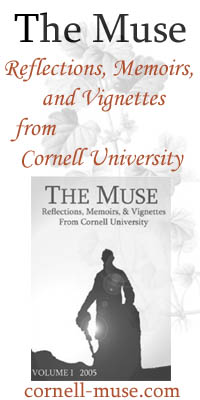Dan Jost '05 Asks If We Can Send a Better Message Than 'Ineffective' Bridge Barriers
Editor's Note: This post is the second in two-part series questioning Cornell's decision to go forward with bridge barriers by Dan Jost '05, a journalist (and landscape architect) with Landscape Architecture Magazine.
In the first half of this series, I presented two cases where putting up a suicide barrier on an iconic bridge had no effect on the overall jumping suicide rate. These studies call into question how effective suicide barriers could be at a place like Cornell, where gorges, bridges, and overlooks are ubiquitous.
Only one study, of the Clifton Suspension Bridge in Bristol, England, has shown a significant drop in jumping suicides in the surrounding region after a suicide barrier went up, and then only among men (jumping rates for women actually rose significantly during the period). Mark Sinyor and Anthony J. Levitt dismissed this study (and the study in Bern) in the British Medical Journal this July saying it ďlacked statistical power because of the relatively small yearly decreases in numbers of suicides at [the] bridge as well as low rates of suicide in general.Ē The sample studied is less than half that of the Bloor Street Viaduct study.
But Cornell has looked at the study hopefully. They feel it may provide insight into the effectiveness of putting barriers on Cornellís bridges, while not fencing off every last gorge. Almost all of the suicides at the Clifton Suspension Bridge prior to the construction of a barrier occurred from the center of the bridge, where it passed
over water. After the barriers went up there, some suicides did migrate to the edges of the bridge, but not nearly as many people jumped from that site overall as had jumped there before.
But we donít know that the barriers actually stopped these men from killing themselves. Itís possible that many people who had heard media reports of the barrier but donít pass over the bridge on a regular basis didnít realize it was still possible to kill yourself there, so they didnít ever go there to attempt suicide. One canít rule out that these men chose another deadly method to kill themselves, as the number of jumpers was far too small to impact the overall suicide rate.
Men in areas without suicide bridges tended to successfully substitute jumping with overdosing, in a national survey of suicides in Switzerland by Thomas Reisch, Ursula Schuster, and Konrad Michel, published in Suicide and Life Threatening Behavior in December 2007. Authored by two of the same authors as the Bern study (see yesterdayís post), the article is once again quite coy about their findings, saying they support the construction of suicide barriers.
"The aim of our study was to compare suicide data from regions with and without suicide bridges and to estimate the effects on method and site substitution if bridges were to be secured," the study explains. "In a national survey, suicide data from the years 1990 to 2003 were collected. Regions with high rates of bridge suicides
were identified and compared to regions with low rates, and the analysis revealed that only about one third of individuals would be expected to jump from buildings or other structures if no bridge was available. The results suggest no method substitution for women. For men, a trend of substituting jumping by overdosing in
regions without suicide bridges was found. We conclude that restricted access to suicide bridges will not automatically lead suicidal individuals to choose another jumping site or suicide method. The results support the notion that securing bridges may save lives."
That conclusion seems bizarre, given the facts they uncovered. A table at the very end of the report compares the suicide rates in cantons with suicide bridges and cantons without suicide bridges. (Cantons are similar to counties). It shows no significant difference between the two in the mean rate of suicides by all methods,
after that rate has been corrected for population density, religion, unemployment, and language spoken, which were all shown to affect the suicide rate. The corrected average rate for cantons with suicide bridges is 18.95 per 100,000. The corrected average rate for cantons without suicide bridges is 18.77 per 100,000. (They do not show uncorrected averages).
Neither men nor women show a significant difference in suicide rates overall when they live in places without suicide bridges. Significantly more people jump from other high places when bridges are not available (especially womenóto the point that there is little need for method substitution). And some people choose other deadly means (especially men).
Given that studyís findings, itís worth reflecting on the fact that both Cornell University and Tompkins County as a whole have lower suicide rates than average (for the figures, see my article in Landscape Architecture Magazine here. If the gorges
were luring people in as some claim, if they were encouraging people to take their lives impulsively who wouldnít have done so if the gorges werenít there, wouldnít that show up in these figures?
Nowhere else in the world do so many stressed out students walk across gorges on a daily basis with the knowledge that those gorges have been used for suicide in the past. So, why has Cornellís suicide rate been lower than the national average for other colleges over the last 21 years? How did Cornell go four years without a single student suicide?
--
None of this means to suggest that it is impossible to reach people who are contemplating suicide or that suicide is inevitable. But it should lead us to question whether putting up barriers is the best way to prevent suicide, as Beautrais, Caine, and Gouldís report stated. The evidence just isnít there.
While Cornellís mental health services are better than at most other colleges, a recent article in the Cornell Daily Sun suggested that the demand for counseling services is still significantly outstripping the supply that the University is able to provide. And instead of spending its limited funds on increasing counseling or other mental health services, which nobody sees, Cornell has put most of its new suicide prevention resources into the barriers.
There is no proof that improving counseling or other services will save any lives either, but it sure seems to send a better message to students in crisis. Putting up a barrier merely says take your problems elsewhere, we donít want your death to be associated with our school. Using that money for counseling services says that we
will do everything we can to help you.


